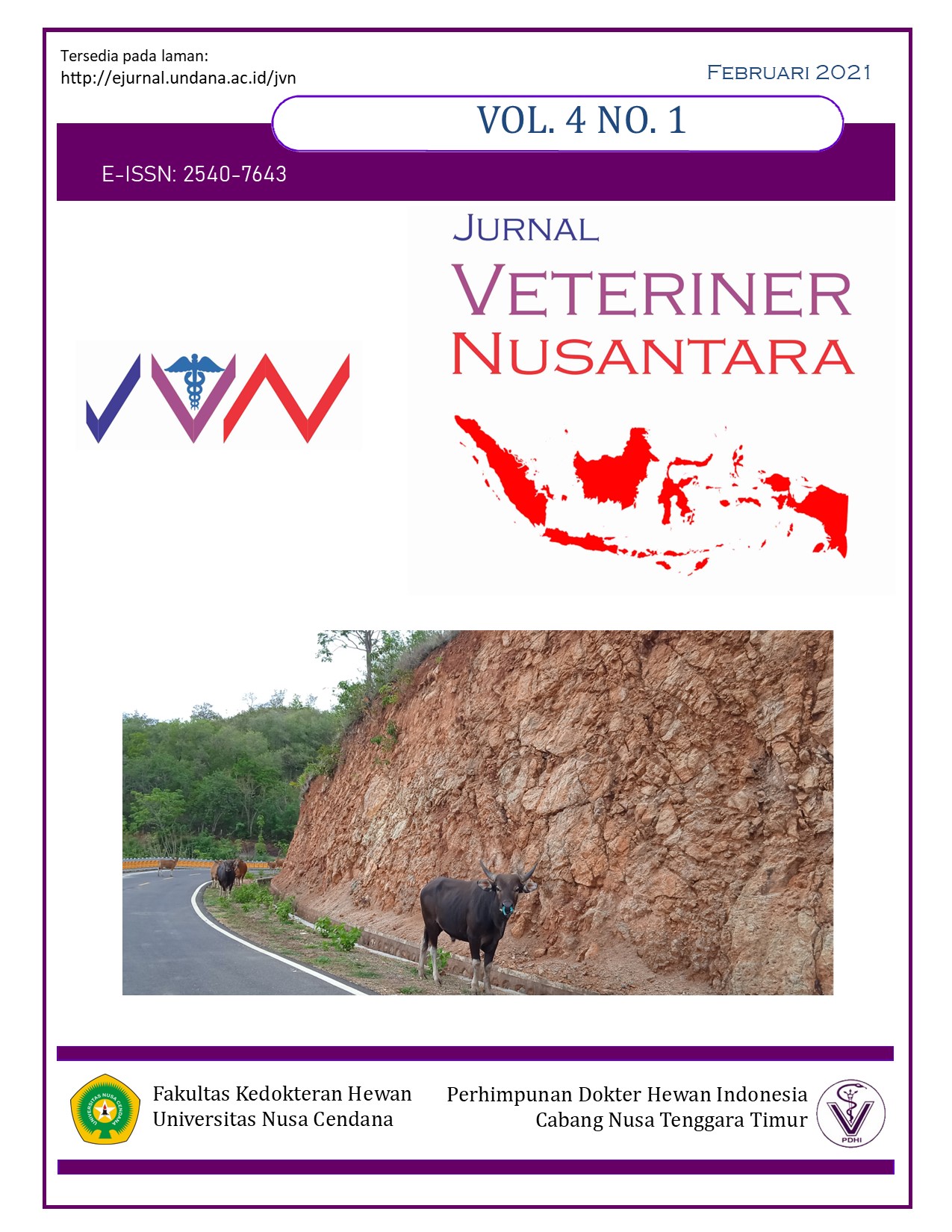Prevalensi Escherichia coli Pada Daging Sapi Di Rumah Potong Hewan Oeba Kota Kupang
Abstract
Meat is one of the livestock products that cannot be separated from the needs of human life. The biggest possibility of bacterial contamination can occur in slaughterhouse (RPH). One of the bacteria that can contaminate meat is Escherichia coli. Escherichia coli (E. coli) is a bacterium that normally lives in the digestive tract of animals and humans. In general, E. coli is considered a normal flora in the digestive tract of animals (cows) that can contaminate meat and the environment around the slaughterhouse during the slaughter process. Beef which was contaminated initially accompanied by improper cooking process is a source of infection from several cases of food poisoning, including those caused by STEC. So that it is necessary to increase food safety for foods that come from animals such as beef or the processed of products to be able to guarantee the quality of food that will be consumed by the community and can prevent Foodborn disease. The sampling method was carried out using a purposive sampling method. Isolation and identification of bacteria was carried out on Eosin Methylene Blue Agar (EMBA) media, and then continued with other tests to confirm the positive Escherichia coli bacteria. On Eosin Methylene Blue Agar (EMBA) media, positive colonies of Escherichia coli are metallic green with black spots in the middle. Eosyn Methylene Blue Agar is a differential medium used to distinguish E. coli from other Enterobactericeae. The sample used was beef taken in Oeba RPH Kupang City when the slaughter was in progress. Samples taken were 41 beef samples in Oeba RPH. The results showed that from 41 beef samples, 4 positive samples of Escherichia coli (9,75%).
Downloads
References
Atalla, H.N., R. Johnson, S. Mcewan, R. W. Usborne, dan C.L. Gyles. 2000. Use of Shiga Toxin (Stx)-Enzyme-Linked Immunosorbent Assay and Immunoblot for Detection and Isolation of Stx-Producing Escherichia coli from Naturally Contaminated Beef. J. Food Prot. 63:9. 1167-1172Besung INK. 2010, Kejadian Kolibasilosis Pada Anak Babi. Majalah Ilmiah Peternakan.Vol.13, No.1.
Barlow, R.S., K.S. Gobius., and P.M. Desmarchelier.2006. Shiga toxin-producing Escherichia coli in ground beef, Int. J. Food Microbiol, 111:1-5.
Bettelheim KA, 2000. The role of non-O157 VTEC.J of AppliedMicrobiology Symposium Supp. 88:38S-50S.
Bolton, D.J., Duffy, G., O’Neil, C.J., Baylis, C.L., Tozzoli, R., Morabito, S., et al. 2009. Epidemiology and Transmission of Patogenic Escherichia coli.Co-orcination Action Food-ct-2006-036256.Patogenic E. coli Network
Brooks, G.F., Butel, J.S., and Morse, S.A. 2004. Mikrobiologi Kedokteran, Edisi 23, Alih Bahasa: Huriawati, H., Chaerunnisa, R., Alifa, D., Aryana, D. EGC. Jakarta.
Brown, A. 2001. Microbiological Applications Lab Manual 8th Edition. The McGraw-Hill Companies, New York
Carter, G. M. and Wise, D. J. 2004. Essentials of Veterinary Bacteriology and Mycology, 6th edition, Iowa: Iowa State Press.
Cheeptham, N. 2012. Eosin Methylene Blue Agar. Thomson Rivers University, Canada.
Colville, L.J. and Berryhill, D.L. 2007. Identification and Prevention of Handbook Zoonosis, North Dakota State University, North Dakota.
Das KC, Qin W. 2012. Isolation and characterization of superior rumen bacteria of cattle (bos taurus) and potential application in animal feedstuff. J Anim Sci 2(4): 224-228.
Dewantari NRA, Besung INK, Sampurna IP. 2016. Pengaruh pemberian mineral terhadap jumlah bakteri Eschericiacoli dan Coliform Pada Sapi Bali di dataran tinggi dan dataran rendah. Buletin Veteriner Udayana 8(1): 71-78.
Donnenberg, M.S. and Whittam, T.S. 2001. Patogenesis and Evolution of Virulence in Enteropatogenic and Enterohemorrhagic Escherichia coli, Journal of Clinical Investigation, 107(5):539-548.
Doyle, M.P., and Beucher, L.R. 2007. Food Microbiology Fundamentals and Frontiers, 3rd Ed, ASM Press, Washington, 142-143, 249-266.
Doyle, M.P. dan Padhye, V.V. 1998. Escherichia coli. Di dalam Doyle, M.P. (ed). Foodborne Bacterial Pathogen. Marcel Dekker, New York.
Duffy, G., P. Garvey., J. Mainil and J. Coia. 2000. Verocytotoxigenic Escherichia coli in Europe: Pathogenicity and Virulence, Castlenock, Dublin, Ireland. The National Food Centre.pp.447-452.
Duffy, L.L., Grau, F.H., and Vanderlinde, P.B. 2000. Acidb Resistance of Enterohaemorrhagic and Generic Escherichia coli Associated with Foodborne Disease and Meat, International Journal of Food microbiology, 60:83-89.
Gani, A. 2003. Metode Diagnostik Bakteriologi III. Balai Laboratorium Kesehatan Makasar.
Ganiswarna S. G. 1995. Farmakologi dan Terapi, ed. 4, UI-Fakultas Kedokteran, Jakarta.
Gracey, J., Collins, D.S., and Huey, R., 1999. Meat Hygiene. 10th ed. London: W.B. Saunders Co, 674.
Gyles, C.L. 1993. Escherichia coli cit. Pathogenesis of Bacterial Infection in Animal. Gyles, C.L., Thoen, C.O. (eds). 2ndEd. Iowa State University Press.Ames, USA.: 164-187.
Hemraj, V., Diksha and Avneet. 2013. A review on commonly used Biochemichal Test for bacteria. Innovare. Journal of Life Science. 1 (10). Hal. 1-7.
Jay, J.M. 1992. Modern Food Microbiology. 4th Ed. New York, Van Nostrand Reinhold.
Jawetz, E., J. Melnick and E. Alberg.1995. Mikrobiologi Kedokteran, Edisi 20, Penerbit EGC, Jakarta.
Kadarsih S. 2004. Performans sapi bali berdasarkan ketinggian tempat di daerah transmigrasi Bengkulu: I.Performance Pertumbuhan. J IlmuPertanian Indonesia 6(1):50-56.
Lawrie, R.A. 2003. Ilmu Daging Edisi Kelima. Terjemahan Aminuddin Parakkasi. UI Press, Jakarta.
Leboffe, M.J. and Pierce, B.E. 2012. Brief Microbiology Laboratory Theory and Application, 2nd Edition, Englewood : Morton Publishing.
Lukman DW. 2004b. Meat Hygine (Tidak untuk diplubikasikan). Bahan Kuliah Sekolah Pasca serjana Institut Pertanian Bogor.
Mahon, C.R., and Manuselis, G. 2000. Textbook of Diagnostic Microbiology, 2ndEd, Saunders, An imprint of Elsevier.
Nasronudin.2007. Penyakit Infeksi di Indonesia, Airlangga University Press, Surabaya, Indonesia.
Pelczar, C.J. and E.C.S. Chan. 1988. Elements of Microbiology, Penerjemah Hadioetomo, R.S., T. Imas, S.S. Tjitrosomo dan S.L. Angka, Edisi ke-1, Indonesia University Press, Jakarta.
Pramita IDADP, Besung INK, Sampurna IP. 2016. Jumlah non coliform dan total bakteri pada sapi bali di dataran tinggi dan dataran rendah di bali pasca pemberian mineral. Buletin VeterinerUdayana 8(1): 52-5
Quinn, P.J., Markey, B.K., Carter, M.E., Donnelly, W.J., dan Leonard, F.C. 2002. Veterinary Microbiology and Microbial Disease, Blackwell Science, Australia.
Rahadi, U. S. E. 2011. Isolasi Escherichia coli dari Daging Sapi yang Dijual di Pasar Tradisional Surabaya Selatan. Surabaya: Fakultas Kedokteran Hewan Universitas Airlangga.
Rahayu, S. A. dan M. H. Gumilar. 2017. Uji cemaran air minum masyarakat sekitar Margahayu Raya Bandung dengan identifikasi bakteri Escherichia coli. IJPST. 4(2):53.
Smith, D.G.E., Naylor, W.S., and Gally, D.L. 2002, Consequence of EHEC Colonisation in Human and Cattle, International Journal Med. Microbiology, 292:168-183.
Smith-Keary P. F., 1988, Genetic Elements in Escherichia coli, Macmillan Molecular Biology Series, London, p. 1-9, 49-54.
Soares FS, Dryden GM. 2011. A body condition scoring system for bali cattle. Asian-Aust J Anim Sci 24(11): 1587-1594.
Soeparno. 1992. Mikrobiologi dalam Pengolahan Pangan Bandung : Penerbit Alumni Bandung.
Soeparno. 2005. Ilmu dan Teknologi Daging. Cetakan ke-4. Gajah Mada University Press, Yogyakarta.
Songer, J. G. and Post, K. W. 2005, Veterinary Microbiology: Bacterial and Fungal Agents of Animal Disease, 1st ed., 434 pp. Elsevier Saunders, St. Louis, MO. SBN 0-7216-8717-2.
Sridhar, RPN. 2006. IMViC reaction. JJMMC
Suardana I.W., Artama W.T., Asmara W., Daryono B.S. 2010, Identifikasi Escherichi coliO157:H7 serta Deteksi Gen Shiga Like Toxin 1 dan 2 Asal Feses Hewan, Daging dan Feses Manusia, Jurnal Veteriner, 11(4):264-270.
Sudiro, T.M. 1994, Mikrobiologi Kedokteran, Binarupa Aksara, Jakarta, Indonesia.
Sullivan, J.O., Bolton, D.J., Duffy, G., Baylis, C., Tozzoli, R., Wasteson, Y., et al. 2007, Methods for Detection and Molecular, Pathogenic Escherichia coli Network.
Sumarno.2000, Isolasi dan Indentifikasi Bakteri Klinik, Akademik Analisis Kesehatan, Yogyakarta.
Usmiati, S. (2010). Pengawetan Daging Segar dan Olahan. Bogor : Balai besar Penelitian dan Pengembangan Pascapanen Pertanian.
Waluyo, L. 2008, Teknik dan Metode Dasar dalam Mikrobiologi, Universitas Muhammadiyah Malang Press, Malang, Indonesia.

 Sera Marbella Christin Langgar(1*)
Sera Marbella Christin Langgar(1*)



 Visit Our G Scholar Profile
Visit Our G Scholar Profile




